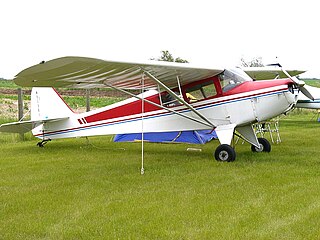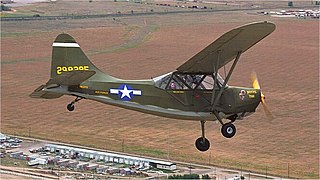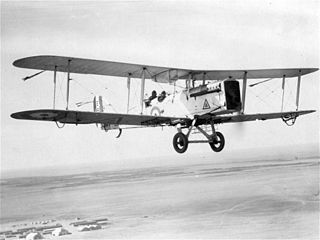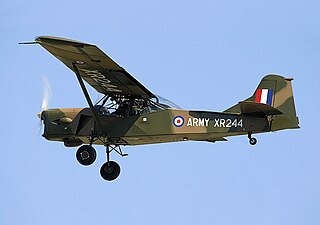
Auster Aircraft Limited was a British aircraft manufacturer from 1938 to 1961.

The Westland Lysander is a British army co-operation and liaison aircraft produced by Westland Aircraft that was used immediately before and during the Second World War.

The Stinson Reliant is a popular single-engine four- to five-seat high-wing monoplane manufactured by the Stinson Aircraft Division of the Aviation Manufacturing Corporation of Wayne, Michigan.

Taylorcraft Aviation is an airplane manufacturer that has been producing aircraft for more than 70 years in several locations.

No. 16 Air Observation Post Flight was a Royal Australian Air Force (RAAF) unit that saw action in World War II supporting Australian Army operations. It was formed in October 1944 and disbanded in June 1947. The flight was reestablished in September 1958, and was disbanded again in December 1960, when its responsibilities were transferred to a joint Army-RAAF unit.
No. 666 Squadron AAC (V) is a former squadron of the British Army's Army Air Corps (AAC). It was previously No. 666 Squadron RAF, a unit of the Royal Air Force during the Second World War and afterwards became a Royal Auxiliary Air Force (RAuxAF) squadron between 1 May 1949 and 10 March 1957.

The Stinson L-5 Sentinel is a World War II-era liaison aircraft used by the United States Army Air Forces (USAAF), U.S. Army Ground Forces, U.S. Marine Corps and the British Royal Air Force. It was produced by the Stinson Division of the Vultee Aircraft Company. Along with the Stinson L-1 Vigilant, the L-5 was the only other USAAF liaison aircraft that was exclusively built for military use and had no civilian counterpart.

Army Aviation Centre (AAC) Middle Wallop is a British Army airfield located near the Hampshire village of Middle Wallop, used for Army Air Corps training. The base hosts 2 (Training) Regiment AAC and 7 (Training) Regiment AAC under the umbrella of the Army Aviation Centre. 2 (Training) Regiment performs ground training; 7 (Training) Regiment trains aircrew on AAC aircraft after they complete basic training at RAF Shawbury.

The Airco DH.9A is a British single-engined light bomber that was designed and first used shortly before the end of the First World War. It was a development of the unsuccessful Airco DH.9 bomber, featuring a strengthened structure and, crucially, replacing the under-powered and unreliable inline 6-cylinder Siddeley Puma engine of the DH.9 with the American V-12 Liberty engine.

The Auster J/1 Autocrat was a 1940s British single-engined three-seat high-wing touring monoplane built by Auster Aircraft Limited at Rearsby, Leicestershire.

No. 17 Air Observation Post Flight was a Royal Australian Air Force artillery-spotting and liaison unit which saw action as part of the Bougainville campaign and New Britain campaign in World War II. The flight was established in October 1944 and disbanded in December the next year.

The Auster AOP.6 was a British military air observation aircraft produced by Auster Aircraft Limited to replace the numerous wartime Taylorcraft Auster aircraft then in-service.

The Auster AOP.9 was a British military air observation aircraft produced by Auster Aircraft Limited to replace the Auster AOP.6.
No. 663 Squadron was an air observation post (AOP) unit, manned with Polish Army personnel, which was officially formed in Italy on 14 August 1944. Numbers 651 to 663 Squadrons were air observation post units working closely with Army units in artillery spotting and liaison. A further three of these squadrons, 664–666, were manned with Canadian personnel. Their duties and squadron numbers were transferred to the Army with the formation of the Army Air Corps on 1 September 1957.
No. 666 Squadron RCAF was originally an RCAF air observation post (AOP) squadron formed during the Second World War. It was manned principally by Royal Canadian Artillery (RCA) and Royal Canadian Air Force (RCAF) personnel.
No. 665 "Air Observation Post" Squadron, RCAF was formed in England during the Second World War. It was manned principally by Royal Canadian Artillery (RCA) and Royal Canadian Air Force (RCAF) personnel, with select British artillery pilots briefly seconded to assist in squadron formation. Numbers 651 to 663 Squadrons of the RAF were air observation post units working closely with Army units in artillery spotting and liaison. A further three of these squadrons – Nos. 664, 665 and 666 – were RCAF AOP squadrons manned by Canadian and British personnel.
No. 664 "Air Observation Post" Squadron RCAF was formed in England during the Second World War. It was manned principally by Royal Canadian Artillery (RCA) and Royal Canadian Air Force (RCAF) personnel, with select British artillery pilots briefly seconded to assist in squadron formation.

An air observation post (AOP) is an aeroplane or helicopter used in the role of artillery spotter by the British Army and Commonwealth forces. In this role, either the pilot of the aircraft or another crew member acts as an observer watching for targets on the ground, and/or as a forward observation officer directing the fire, by radio, of artillery on the ground.
No. 661 Squadron AAC is a squadron of the British Army's Army Air Corps (AAC). It was formerly No. 661 Squadron, a Royal Air Force air observation post squadron associated with the Canadian 1st Army and later part of the Royal Auxiliary Air Force. Numbers 651 to 663 Squadrons of the RAF were air observation post units working closely with British Army units in artillery spotting and liaison. A further three of these squadrons, 664–666, were manned with Canadian personnel. Their duties and squadron numbers were transferred to the Army with the formation of the Army Air Corps on 1 September 1957.
664 Squadron AAC is a squadron of the British Army's Army Air Corps. It was formerly No. 664 Squadron, a Royal Air Force air observation post squadron associated with the Canadian 1st Army during the Second World War and later part of the Royal Auxiliary Air Force. Numbers 651 to 663 Squadrons of the RAF were air observation post units working closely with British Army units in artillery spotting and liaison. A further three of these squadrons, 664–666, were manned with Canadian personnel. Their duties and squadron numbers were transferred to the Army with the formation of the Army Air Corps on 1 September 1957.




















